| Article ID | Journal | Published Year | Pages | File Type |
|---|---|---|---|---|
| 277548 | International Journal of Solids and Structures | 2014 | 12 Pages |
High-performance stretchable electronics have to utilize high-quality inorganic electronic materials such as silicon, oxide or nitride dielectrics, and metals. These inorganic materials usually crack or yield at very small intrinsic strains, for example, 1%, whereas bio-integrated electronics are expected to at least match the stretchability of bio-tissues (20%) and deployable structure health monitoring networks are expected to expand from wafer scale (several centimeters) to cover macroscopic structures (several meters). To minimize strains in inorganic materials under large deformation, metallic and ceramic films can be patterned into serpentine-shaped ribbons. When the ribbon is stretched, some sections of the ribbon can rotate and/or buckle to accommodate the applied displacement, leaving much smaller intrinsic strain in the materials compared to the applied strain. The choice of the shape of the serpentine depends on systematic studies of the geometric variables. This paper investigates the effect of serpentine shapes on their stretchability and compliance through theoretical, numerical, and experimental means. Our closed-form curved beam solutions, FEM results, and experimental measurements have found good agreement with one another. Our results conclude that in general, the narrower ribbon, the larger arc radius and arc angle, and the longer arm length will yield lower intrinsic strain and effective stiffness. When the arm length approaches infinite, the stretchability can be enhanced by several orders. A few unexpected behaviors are found at arc angles that are close to straight bars. With additional practical constraints such as minimum ribbon width and finite overall breadth, the optimal serpentine shape can be accurately determined using our closed-form analytical solution.
